Immigrant population in Germany
Table of Contents
- Most Common Nationality Other Than German In Each State Of Germany
- The most common immigrant citizenship in each German district
- The most common groups of resident foreign nationals in Germany
- Change in foreign population of German states (2010 – 2017)
- Most common gender among immigrant groups in Germany
Germany is the 2nd most popular migration destination in the world, after the U.S. Of all the 27 EU states, Germany has the second-highest percentage of immigrants in its population after the United Kingdom.
Germany experienced significant labor migration during the post-World War II period, known as the “Wirtschaftswunder” or economic miracle. Many guest workers, primarily from Turkey, were invited to fill labor shortages. Some of them and their families have since become long-term residents.
Moreover, Germany has been a destination for refugees and asylum seekers from conflict zones and other troubled regions. The country has accepted a substantial number of refugees, particularly during the European migrant crisis that began in 2015. This has led to an increase in the number of asylum seekers and refugees in Germany.
In 2020, the Federal Statistical Office of Germany (Statistisches Bundesamt) reported that there were approximately 10.9 million foreign residents living in Germany. This figure includes both individuals with foreign citizenship and individuals with German citizenship who were born abroad.
According to the Federal Statistical Office of Germany in 2022, the most people without German citizenship were Turkish (1.5 million), followed by Polish (0.87 million), Syria (0.70 million), Italy (0.64 million), and Romania citizens (0.62 million). It is estimated 3 million people of Turkish heritage nowadays lives in Germany.
The maps below shows the nation of citizenship for the biggest group of newcomers by the German divisions.
Most Common Nationality Other Than German In Each State Of Germany
The first map of Germany, which illustrates the most common nationality other than German in each state in 2024, highlights the diverse immigrant population across the country.
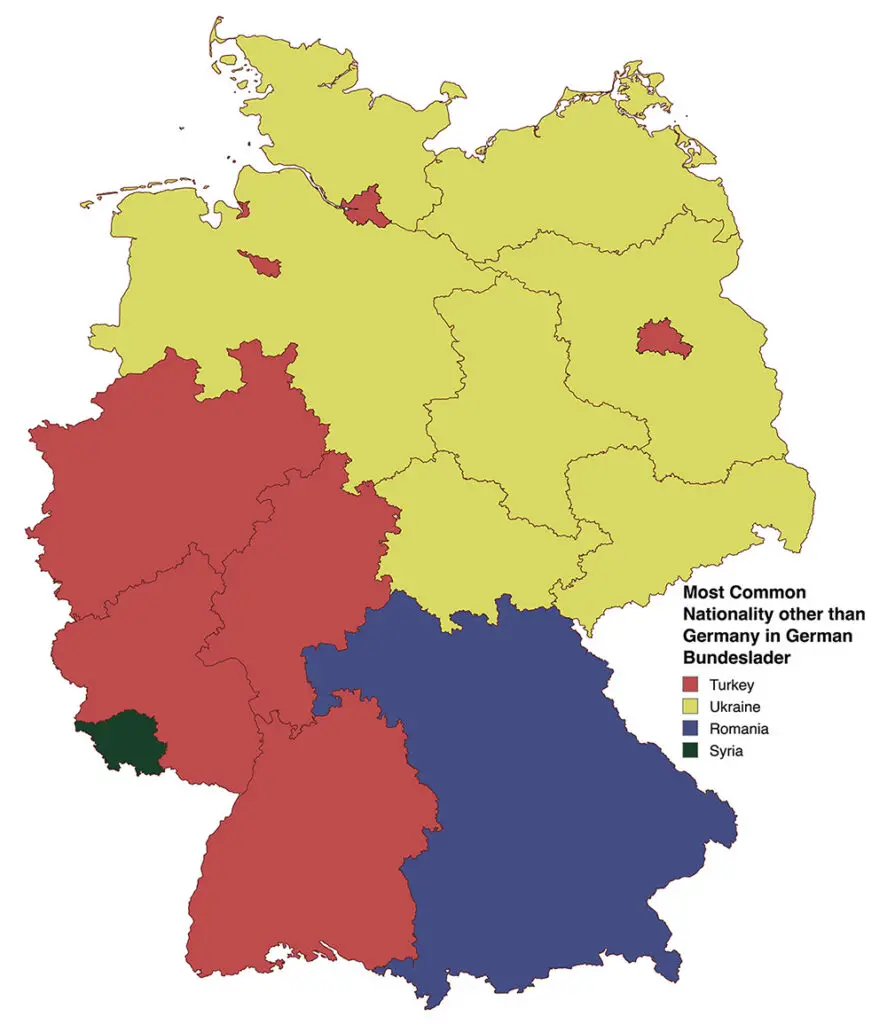
This map vividly illustrates the varied and dynamic composition of Germany’s foreign-born population, with significant communities from Turkey, Ukraine, Romania, and Syria, each contributing to the multicultural tapestry of the nation.
The most common immigrant citizenship in each German district
Turks, Italians, Portuguese, Greeks (who are not the leading minority in any division) and others immigrated in large amounts to West Germany as guest workers to provide an additional workforce to the then-thriving economy. Turks make up by far the biggest group with over 1.5 million existing in Germany.
In the east, the number of immigrants is generally lower, in many rural eastern regions, the percentage is under 2%, or even under 1%.
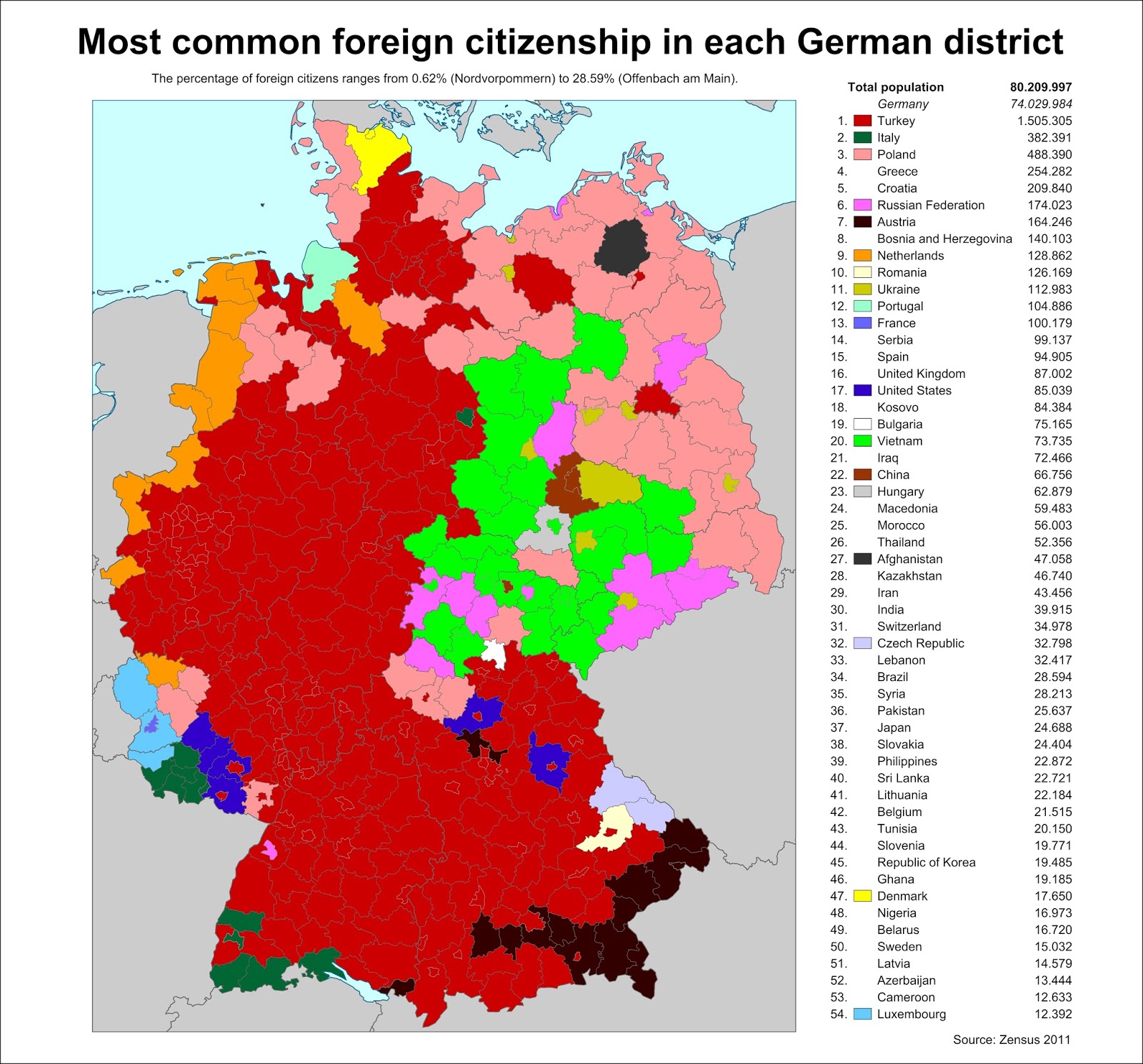
The region with the largest immigrant citizens is Offenbach am Main at 28.6 percent, whereas Nordvorpommern has the lowest number at just 0.6 percent.
The most common groups of resident foreign nationals in Germany
| Rank | Nationality | Population | % of foreign nationals |
|---|---|---|---|
| 1 | Turkey | 1,483,515 | 14.9 |
| 2 | Poland | 866.855 | 8.2 |
| 3 | Syria | 698.95 | 6.6 |
| 4 | Italy | 643.065 | 6.1 |
| 5 | Romania | 622.78 | 5.9 |
| 6 | Croatia | 367.9 | 3.5 |
| 7 | Greece | 362.245 | 3.4 |
| 8 | Bulgaria | 310.415 | 2.9 |
| 9 | Afghanistan | 251.64 | 2.4 |
| 10 | Russia | 249.205 | 2.3 |
| 11 | Iraq | 237.365 | 2.2 |
| 12 | Serbia | 225.535 | 2.1 |
| 13 | Hungary | 207.025 | 1.9 |
| 14 | Austria | 191.305 | 1.8 |
| 15 | Bosnia and Herzegovina | 180.95 | 1.7 |
| 16 | Netherlands | 154.63 | 1.5 |
| 17 | Spain | 178.01 | 1.7 |
| 18 | Ukraine | 138.045 | 1.3 |
| 19 | France | 149.025 | 1.4 |
| 20 | Portugal | 146.81 | 1.4 |
| 21 | China | 136.46 | 1.3 |
| 23 | United States | 117.73 | 1.1 |
| 24 | United Kingdom | 116.465 | 1.1 |
| 25 | India | 108.965 | 1.0 |
| 26 | Iran & Kurdistan Province | 102.76 | 1.0 |
| 27 | Macedonia | 99.435 | 0.9 |
| 28 | Vietnam | 92.485 | 0.9 |
| 29 | Morocco | 75.62 | 0.7 |
| 30 | Pakistan | 73 | 0.7 |
In recent times, the most significant growth of immigrants observes in East Germany. The map of Germany below created by @trinitronbxb shows changes in foreign population in the country.
Change in foreign population of German states (2010 – 2017)
The most considerable growth of immigrant population observes in Saxony-Anhalt (+135%) and Thuringia (+92%).

And in conclusion, an interesting map about the gender composition of migrants by countries of the world.
Most common gender among immigrant groups in Germany
Citizens from the nations shown in red come to Germany primarily to work. Residents of states colored green mainly come to Germany to get married.
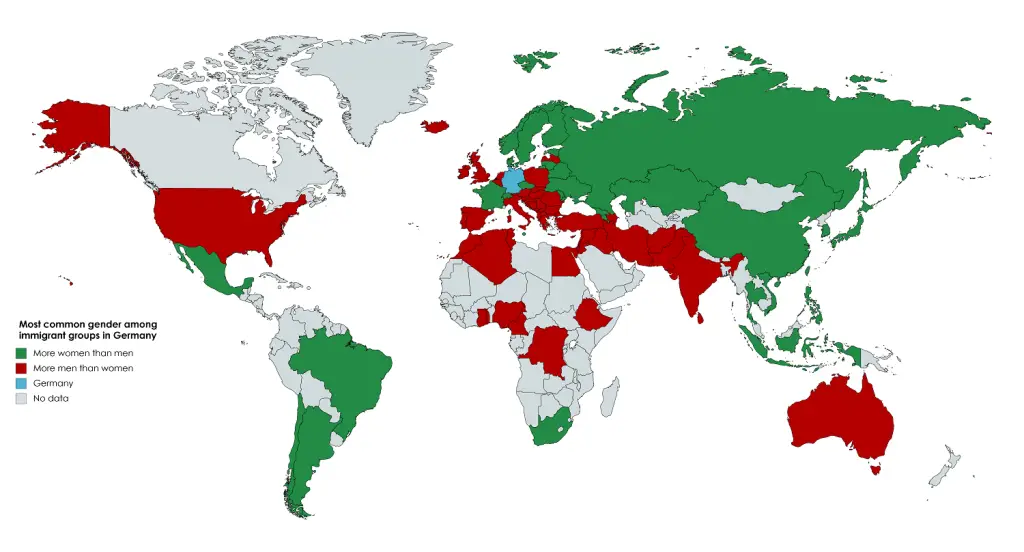
To learn more about Germany, see:




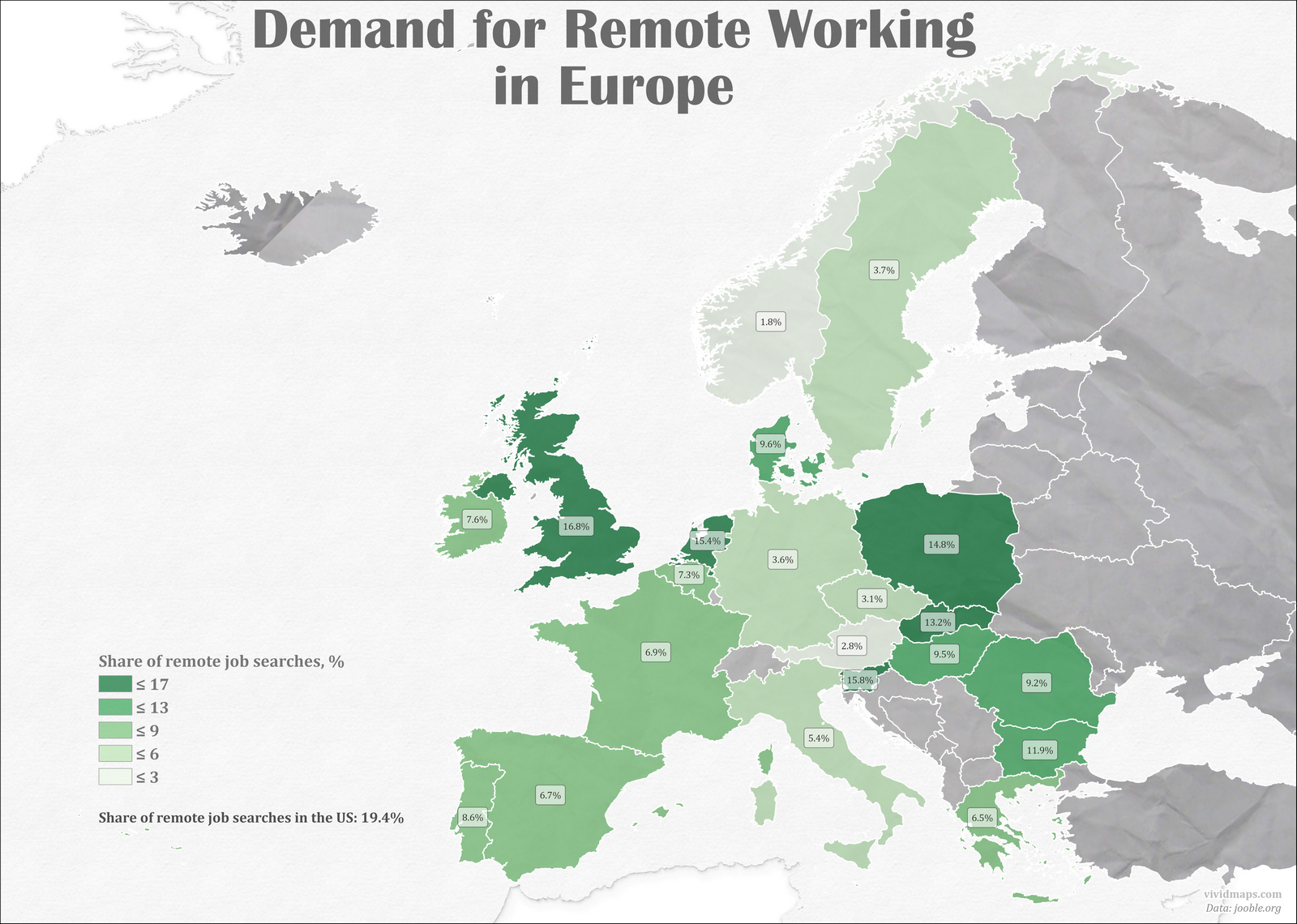
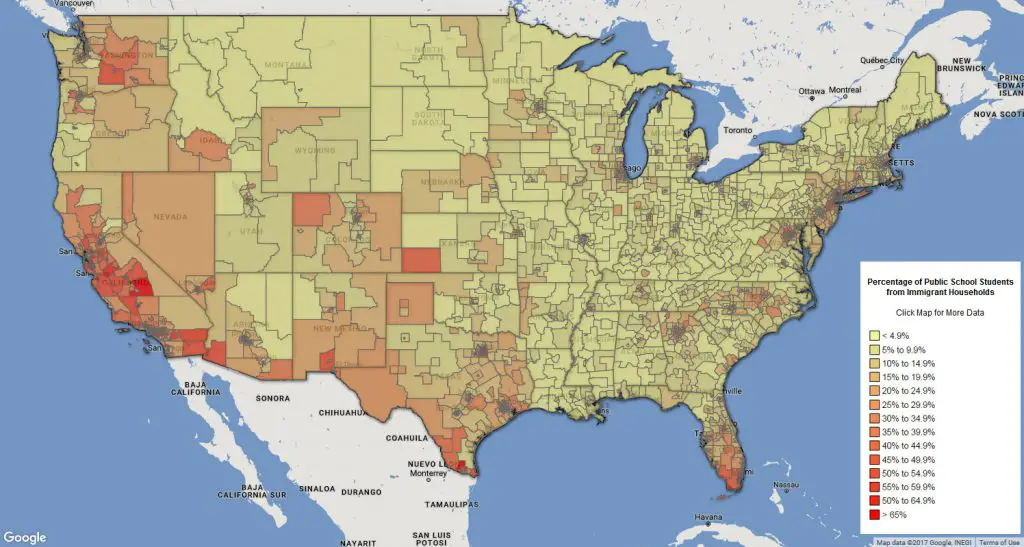
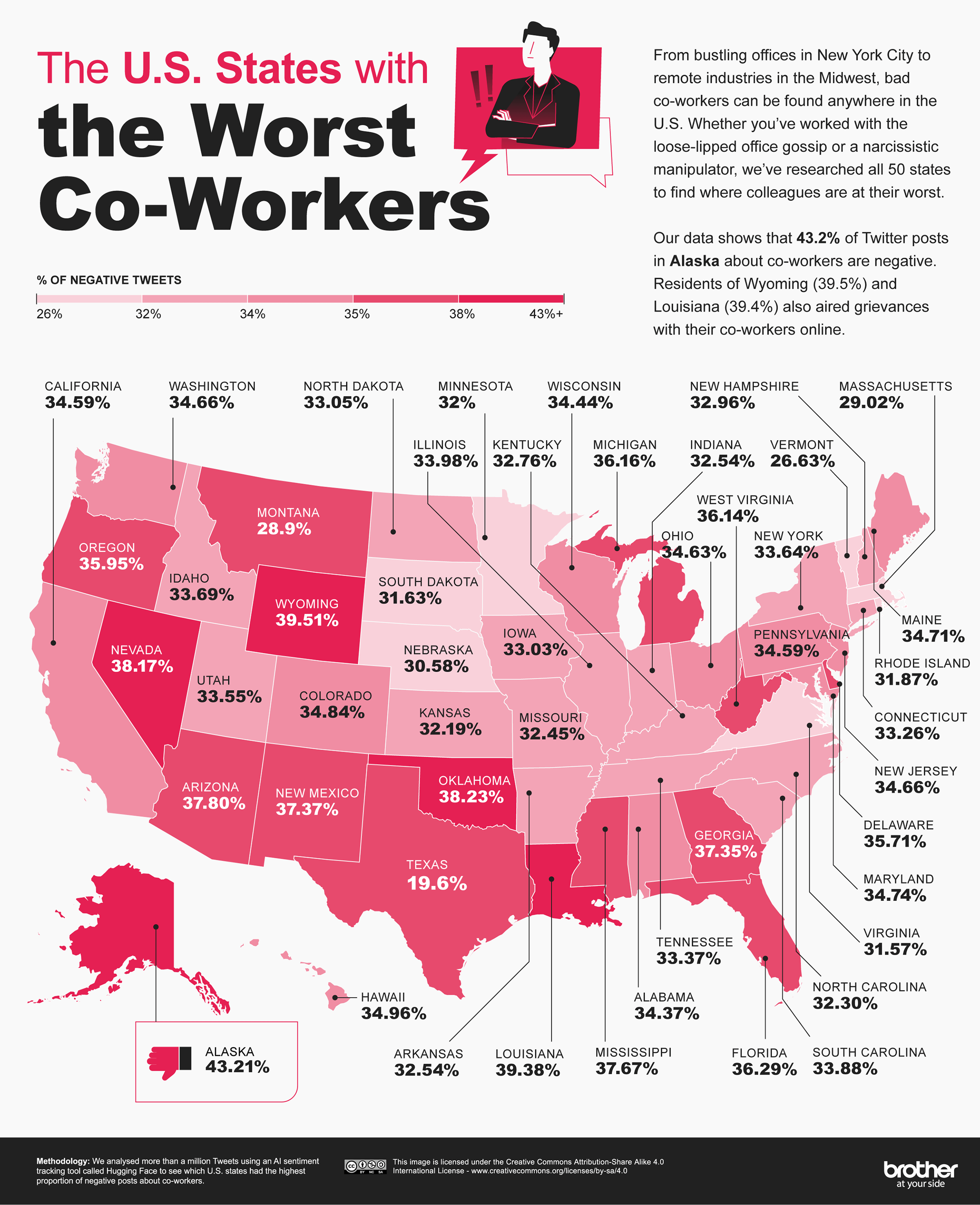


If “foreign” means those born to immigrants then it would explain a lot about the hard numbers in the eastern states
.
Also, single Male foreigners may be more located in cities and industrial states
.
And, the eastern states may have lower cost of living